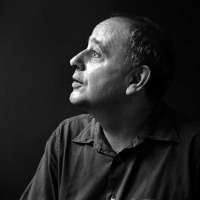Mateo Arquitectura projected this building in 1996 thinking that was like a tree, but a petrified tree, which was sinking in the ground, anchoring inside it (safes were traditionally hidden in the ground), that had a different materialization with regard to the sky. The hardness of the stone would be diluted at the time of stay in contact with the exterior space to turn into onyx and alabaster.
Description of the project by Mateo Arquitectura
Eight years have passed from the competition (1996) until now (2004). During this time multiple strategies have had to be devised. Here I will only indicate the ones that correspond to the material issues of the object.
The structure was designed by Leonardt, Andra und Partner in a very intelligent way: the façades of the two upper floors are mega-supporting walls which are on top of the communication nuclei. These support the floor of the first floor by means of traction cables. Therefore, there is no interior support on the ground floor.
The façades are made of local stone with a very precise, explicitly archaic and abstract design: the corners are made of a single cut stone; in the base of the floor a harder rougher stone is used. The first stones have a slightly different texture.
There is a lot of craftsmanship tension as a methodological strategy in the entire project.
The translucent façade is formed by a complex system of layers of glass, insulating chambers and thick alabaster. It has been an enormous undertaking (which is still not finished) to construct it, but we architects are here (among other things) for that: to solidify shapeless ideas into material.
At times it seems like solidified water (ice) and at other times the internal seams of the material form vegetation drawings.
The windows are very sophisticated: bronze and wooden. On the ground floor there is a large bronze wall which contains all the openings. This is all constructed within a hard frame of diabolical perfection which makes them unrepeatable and timeless.
The interior of the entrance hall, the most monumental and public part of the building, uses the metaphor of the fossil, superimposing stones and pieces of trees. The Czech artist, P. Kvicala, painted a grand ceiling. Among other aspects of his works, what interests me is the way he carries it out: painting a 200m² ceiling by hand is within the unhistoric logic of the building.
The garden is very simple: the hard pavements mark the line of circulation. The rest is simply gravel or plantations of small bushes and ground covers, chosen because of their being prehistoric species.
The exact place where we had to construct had a great impact on me; it was the interior of a park with a beautiful name which was significant to me: The Park of the Victims of Fascism.
However, talking about the park does not do justice to the place. It is not the typical kind urban space with nature which is more or less domesticated, with children playing in it. It is a wild wood with enormous hundredyear- old trees, which even in summer do not let sunlight reach the ground. With minimal intervention, full of mystery and accidents which referred to the dramatic history of Europe: a French patrol which had fallen in the Napoleonic wars was buried with its burial mounds covered in ivy and arranged in strictly hierarchical order; a monument commemorating those lost in World War Two was semi-abandoned…
Adolf Loos defended the tomb as the highest expression of architecture. Those burial mounds were already a sign. And the large trees were a real reference. Seen as buildings, they were impressive: roofs (buried parts that penetrated the earth) the trunk and the large tops.
As if guided by a mysterious force, I immediately found another fascinating place: the city Palaeontology Museum. In its immediate surroundings, as an advertising slogan, some petrified trees advertised its contents. The arrangement of the museum, which did not seen to have changed much since the nineteenth century, followed the rationalist encyclopaedism logic of the tradition of Humboldt and explained that alchemic transformation which leads living organic material, to an inert petreous inorganic condition. Its beautiful catalogue, full of highly artistic potential, has accompanied us throughout all these years.
Our destiny was thus decided: we had to think of a building as if it were a tree, but a petrified tree, which would sink into the ground anchoring itself in it (safes were traditionally hidden in the ground), which would have a variable shape in relation to the sky and in which the inorganic hardness of the stone would be put to the test in some places, by the exhibition of a solidified former vegetation structure (onyx and alabaster immediately came to mind as possibilities).
In German, construction (bau) and tree (baum) have the same root. There were too many signs for us not to follow them.













































